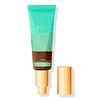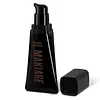Juvia's Place I am Magic Natural Radiance Foundation Versus Il Makiage After Party Next Gen Full Coverage Foundation
What's inside
What's inside
 Key Ingredients
Key Ingredients

 Benefits
Benefits

 Concerns
Concerns

 Ingredients Side-by-side
Ingredients Side-by-side

Water
Skin ConditioningDiethylhexyl Succinate
EmollientUndecane
EmollientPhenyl Trimethicone
Skin ConditioningTrimethylolpropane Triisostearate
EmollientIsododecane
EmollientPropanediol
SolventTridecane
PerfumingAlumina
AbrasiveIsononyl Isononanoate
EmollientTrimethylsiloxyphenyl Dimethicone
Cetyl PEG/PPG-10/1 Dimethicone
EmulsifyingPEG-150
HumectantTrimethylsiloxysilicate
EmollientPolyglyceryl-4 Isostearate
EmulsifyingC12-15 Alkyl Lactate
EmollientEthyl Benzoate
PerfumingDisteardimonium Hectorite
StabilisingSodium Chloride
MaskingAluminum Hydroxide
EmollientCI 77120
Cosmetic Colorant1,2-Hexanediol
Skin ConditioningCaprylyl Glycol
EmollientParfum
MaskingSodium Lauroyl Glutamate
Helianthus Annuus Seed Oil
EmollientDisodium EDTA
Rosmarinus Officinalis Leaf Extract
AntimicrobialRosa Rugosa Leaf Extract
HumectantLysine
Skin ConditioningLactobacillus
Skin ConditioningPrunus Cerasus Fruit Extract
AntioxidantMagnesium Chloride
Xanthan Gum
EmulsifyingTropolone
Skin ConditioningPalmitic Acid
EmollientTocopherol
AntioxidantMagnesium Hydroxide
AbsorbentCI 77492
Cosmetic ColorantCI 77891
Cosmetic ColorantCI 77491
Cosmetic ColorantCI 77499
Cosmetic ColorantWater, Diethylhexyl Succinate, Undecane, Phenyl Trimethicone, Trimethylolpropane Triisostearate, Isododecane, Propanediol, Tridecane, Alumina, Isononyl Isononanoate, Trimethylsiloxyphenyl Dimethicone, Cetyl PEG/PPG-10/1 Dimethicone, PEG-150, Trimethylsiloxysilicate, Polyglyceryl-4 Isostearate, C12-15 Alkyl Lactate, Ethyl Benzoate, Disteardimonium Hectorite, Sodium Chloride, Aluminum Hydroxide, CI 77120, 1,2-Hexanediol, Caprylyl Glycol, Parfum, Sodium Lauroyl Glutamate, Helianthus Annuus Seed Oil, Disodium EDTA, Rosmarinus Officinalis Leaf Extract, Rosa Rugosa Leaf Extract, Lysine, Lactobacillus, Prunus Cerasus Fruit Extract, Magnesium Chloride, Xanthan Gum, Tropolone, Palmitic Acid, Tocopherol, Magnesium Hydroxide, CI 77492, CI 77891, CI 77491, CI 77499
Water
Skin ConditioningIsohexadecane
EmollientSynthetic Fluorphlogopite
Undecane
EmollientNylon-12
Cetyl PEG/PPG-10/1 Dimethicone
EmulsifyingPolymethylsilsesquioxane
Tridecane
PerfumingCI 77120
Cosmetic ColorantTalc
AbrasivePolyglyceryl-4 Isostearate
EmulsifyingSilica
AbrasivePolyglyceryl-2 Triisostearate
EmulsifyingPropanediol
SolventCyclopentasiloxane
EmollientDisteardimonium Hectorite
StabilisingIsononyl Isononanoate
Emollient1,2-Hexanediol
Skin ConditioningCaprylyl Glycol
EmollientParfum
MaskingDimethicone Crosspolymer
Emulsion StabilisingAluminum Hydroxide
EmollientHelianthus Annuus Seed Oil
EmollientSodium Lauroyl Glutamate
Tetrasodium EDTA
Dehydroxanthan Gum
Emulsion StabilisingRosmarinus Officinalis Leaf Extract
AntimicrobialLysine
Skin ConditioningMagnesium Chloride
Palmitic Acid
EmollientTropolone
Skin ConditioningTocopherol
AntioxidantMagnesium Hydroxide
AbsorbentCI 77891
Cosmetic ColorantIron Oxides
Water, Isohexadecane, Synthetic Fluorphlogopite, Undecane, Nylon-12, Cetyl PEG/PPG-10/1 Dimethicone, Polymethylsilsesquioxane, Tridecane, CI 77120, Talc, Polyglyceryl-4 Isostearate, Silica, Polyglyceryl-2 Triisostearate, Propanediol, Cyclopentasiloxane, Disteardimonium Hectorite, Isononyl Isononanoate, 1,2-Hexanediol, Caprylyl Glycol, Parfum, Dimethicone Crosspolymer, Aluminum Hydroxide, Helianthus Annuus Seed Oil, Sodium Lauroyl Glutamate, Tetrasodium EDTA, Dehydroxanthan Gum, Rosmarinus Officinalis Leaf Extract, Lysine, Magnesium Chloride, Palmitic Acid, Tropolone, Tocopherol, Magnesium Hydroxide, CI 77891, Iron Oxides
Ingredients Explained
These ingredients are found in both products.
Ingredients higher up in an ingredient list are typically present in a larger amount.
1,2-Hexanediol is a synthetic liquid and another multi-functional powerhouse.
It is a:
- Humectant, drawing moisture into the skin
- Emollient, helping to soften skin
- Solvent, dispersing and stabilizing formulas
- Preservative booster, enhancing the antimicrobial activity of other preservatives
Aluminum Hydroxide is a form of aluminum. It can be naturally found in nature as the mineral gibbsite. In cosmetics, Aluminum Hydroxide is used as a colorant, pH adjuster, and absorbent.
As a colorant, Aluminum Hydroxide may add opacity, or reduce the transparency. Aluminum hydroxide is contains both basic and acidic properties.
According to manufacturers, this ingredient is an emollient and humectant. This means it helps hydrate the skin.
In medicine, this ingredient is used to help relieve heartburn and help heal ulcers.
There is currently no credible scientific evidence linking aluminum hydroxide in cosmetics to increased cancer risk.
Major health organizations allow the use of aluminum hydroxide in personal care products and have not flagged it as a carcinogenic risk at typical usage levels.
Learn more about Aluminum HydroxideCaprylyl Glycol is a humectant and emollient, meaning it attracts and preserves moisture.
It is a common ingredient in many products, especially those designed to hydrate skin. The primary benefits are retaining moisture, skin softening, and promoting a healthy skin barrier.
Though Caprylyl Glycol is an alcohol derived from fatty acids, it is not the kind that can dry out skin.
This ingredient is also used as a preservative to extend the life of products. It has slight antimicrobial properties.
Learn more about Caprylyl GlycolThis ingredient is a high molecular weight silicone. It has emulsifying and skin conditioning properties.
We don't have a description for CI 77120 yet.
Ci 77891 is a white pigment from Titanium dioxide. It is naturally found in minerals such as rutile and ilmenite.
It's main function is to add a white color to cosmetics. It can also be mixed with other colors to create different shades.
Ci 77891 is commonly found in sunscreens due to its ability to block UV rays.
Learn more about CI 77891Disteardimonium Hectorite comes from the clay mineral named hectorite. It is used to add thickness to a product.
It can also help stabilize a product by helping to disperse other ingredients.
Hectorite is a rare, white clay mineral.
Learn more about Disteardimonium HectoriteHelianthus Annuus Seed Oil is the oil derived from the seeds of a Sunflower. Sunflower seed oil is non-fragrant. It is an emollient, meaning it helps to soften the skin.
Sunflower seed oil contains many fatty acids. The fatty acids found in sunflower seeds include (from highest amount to least): linoleic acid, myristic acid, palmitic acid, stearic acid, arachidic acid, oleic acid, and linolenic acid.
These fatty acids help the skin create ceramides. Ceramides play a role in repairing the skin barrier.
Helianthus Annuus Seed Oil helps moisturize the skin. This in turn helps the skin look more rejuvenated and smoother.
Sunflowers are rich in vitamin E.
Historians believe Indigenous cultures of North America domesticated sunflowers before corn. Thus they relied on sunflower oil for a variety of uses. One such use is moisturizing skin and hair.
Sunflower seed oil may not be fungal acne safe. We recommend speaking with a professional if you have any concerns.
Learn more about Helianthus Annuus Seed OilIsononyl Isononanoate is a synthetic skin-conditioner and texture enhancer. It is created from nonanoic acid, a fatty acid found in cocoa and lavender oil.
As an emollient, Isononyl Isononanoate helps keep your skin soft and smooth. This is because emollients create a barrier on the skin to trap moisture in.
Isononyl Isononanoate helps give products a velvet feel and improves spreadability.
Learn more about Isononyl IsononanoateLysine is an essential amino acid. Your body is unable to produce it naturally and we mainly get lysine from food sources.
Our bodies use lysine for growth and tissue repair. The skin uses amino acids as a precursor for building protein, and therefore keratins, collagen and elastin.
We don't have a description for Magnesium Chloride yet.
We don't have a description for Magnesium Hydroxide yet.
Palmitic Acid is a fatty acid naturally found in our skin and in many plant and animal sources. In cosmetics, it is usually derived from palm oil. It serves many purposes in skincare, acting as a cleanser, emollient, and emulsifier.
As an emollient, palmitic acid helps soften and smooth the skin by preventing water loss. In cleansers, it helps remove oil and dirt while creating foam.
Its emulsifying properties help stabilize products by keeping water and oil-based ingredients from separating.
This may not be suitable for fungal acne-prone skin, as fatty acids like this can sometimes trigger breakouts in sensitive individuals.
Learn more about Palmitic AcidParfum is a catch-all term for an ingredient or more that is used to give a scent to products.
Also called "fragrance", this ingredient can be a blend of hundreds of chemicals or plant oils. This means every product with "fragrance" or "parfum" in the ingredients list is a different mixture.
For instance, Habanolide is a proprietary trade name for a specific aroma chemical. When used as a fragrance ingredient in cosmetics, most aroma chemicals fall under the broad labeling category of “FRAGRANCE” or “PARFUM” according to EU and US regulations.
The term 'parfum' or 'fragrance' is not regulated in many countries. In many cases, it is up to the brand to define this term.
For instance, many brands choose to label themselves as "fragrance-free" because they are not using synthetic fragrances. However, their products may still contain ingredients such as essential oils that are considered a fragrance by INCI standards.
One example is Calendula flower extract. Calendula is an essential oil that still imparts a scent or 'fragrance'.
Depending on the blend, the ingredients in the mixture can cause allergies and sensitivities on the skin. Some ingredients that are known EU allergens include linalool and citronellol.
Parfum can also be used to mask or cover an unpleasant scent.
The bottom line is: not all fragrances/parfum/ingredients are created equally. If you are worried about fragrances, we recommend taking a closer look at an ingredient. And of course, we always recommend speaking with a professional.
Learn more about ParfumThis ingredient is an emulsifer and stabilizer. It comes from isostearic acid and polyglycerin.
As an emulsifier, it helps blend oil and water to improve texture, spreadbility, and application.
Due to it being derived from isostearic acid, this ingredient may not be fungal acne safe.
Learn more about Polyglyceryl-4 IsostearatePropanediol is an all-star ingredient. It softens, hydrates, and smooths the skin.
It’s often used to:
Propanediol is not likely to cause sensitivity and considered safe to use. It is derived from corn or petroleum with a clear color and no scent.
Learn more about PropanediolRosmarinus Officinalis Leaf Extract comes from rosemary. Rosemary is native to the Mediterranean.
While Rosmarinus Officinalis Leaf Oil can be volatile due to its fragrant properties, the fragrance components are usually removed in the leaf extract.
Rosemary Leaf Extract contains many antioxidants such as rosmarinic acid and caffeic acid. Rosemarinic acid, a compound found in rosemary leaf, has been found to help soothe skin conditions such as eczema and acne.
Learn more about Rosmarinus Officinalis Leaf ExtractSodium Lauroyl Glutamate is the sodium salt from the lauric acid of glutamic acid.
It is a surfactant and helps cleanse the skin. Surfactants gather oil, dirt, and other pollutants from your skin so they may be washed away easily.
Tocopherol (also known as Vitamin E) is a common antioxidant used to help protect the skin from free-radicals and strengthen the skin barrier. It's also fat soluble - this means our skin is great at absorbing it.
Vitamin E also helps keep your natural skin lipids healthy. Your lipid skin barrier naturally consists of lipids, ceramides, and fatty acids. Vitamin E offers extra protection for your skin’s lipid barrier, keeping your skin healthy and nourished.
Another benefit is a bit of UV protection. Vitamin E helps reduce the damage caused by UVB rays. (It should not replace your sunscreen). Combining it with Vitamin C can decrease sunburned cells and hyperpigmentation after UV exposure.
You might have noticed Vitamin E + C often paired together. This is because it is great at stabilizing Vitamin C. Using the two together helps increase the effectiveness of both ingredients.
There are often claims that Vitamin E can reduce/prevent scarring, but these claims haven't been confirmed by scientific research.
Learn more about TocopherolTridecane is a lightweight emollient and fragrancing ingredient. It is a paraffin and often called a silicone alternative.
According to official INCI guidelines, this ingredient is used to give a light odor to raw materials. It is often used as a starter ingredient to create parfum.
This ingredient can be derived from palm oil, or coconut oil. It is also naturally found in certain species of organisms.
According to the NOAA, this ingredient can cause skin sensitivity with prolonged use. However, this warning is taken from the Coast Guard and no studies have been done on this in relation to cosmetics.
Tridecane is not water soluble.
Learn more about TridecaneWe don't have a description for Tropolone yet.
Undecane is an emollient and helps create a lightweight base for products.
Is is not soluble in water and naturally occurring in some species.
Water. It's the most common cosmetic ingredient of all. You'll usually see it at the top of ingredient lists, meaning that it makes up the largest part of the product.
So why is it so popular? Water most often acts as a solvent - this means that it helps dissolve other ingredients into the formulation.
You'll also recognize water as that liquid we all need to stay alive. If you see this, drink a glass of water. Stay hydrated!
Learn more about Water